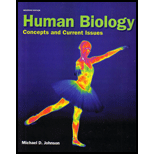
Human Biology: Concepts and Current Issues
7th Edition
ISBN: 9780321821652
Author: Michael D. Johnson
Publisher: Benjamin Cummings
expand_more
expand_more
format_list_bulleted
Concept explainers
Textbook Question
Chapter 2, Problem 8TY
Which of these bonds is the easiest to disrupt, simply by raising the temperature?
a. hydrogen bonds
b. ionic bonds
c. polar covalent bonds
d. nonpolar covalent bonds
e. peptide bonds
Expert Solution & Answer
Want to see the full answer?
Check out a sample textbook solution
Students have asked these similar questions
Briefly state the physical meaning of the electrocapillary equation (Lippman equation).
Explain in a small summary how:
What genetic information can be obtained from a Punnet square? What genetic information cannot be determined from a Punnet square?
Why might a Punnet Square be beneficial to understanding genetics/inheritance?
In a small summary write down:
Chapter 2 Solutions
Human Biology: Concepts and Current Issues
Ch. 2 -
1. Who do you think should be responsible for...Ch. 2 - Prob. 2QCCh. 2 - Describe the electrical charges and relative...Ch. 2 -
2. Explain why two atoms of hydrogen tend to...Ch. 2 -
3. Explain why polar and charged molecules tend...Ch. 2 - How is a covalent bond different from an ionic...Ch. 2 - Compare and contrast potential energy and kinetic...Ch. 2 - Distinguish between saturated and unsaturated...Ch. 2 - Describe the process known as dehydration...Ch. 2 - Explain why proteins come in an almost unlimited...
Ch. 2 -
9. Discuss the importance of enzymes in living...Ch. 2 -
10. Describe the role of ATP in energy transfer...Ch. 2 - If a molecule of starch is repeatedly hydrolyzed,...Ch. 2 - Which of these molecules would be described as...Ch. 2 -
3. _______bonds form between the oxygen and...Ch. 2 - 13C and 14C are ______ of carbon. a. isotopes b....Ch. 2 - Which of the following substances has the lowest...Ch. 2 - When sugar is dissolved in water, sugar is the...Ch. 2 - A monosaccharide is to a polysaccharide as an...Ch. 2 -
8. Which of these bonds is the easiest to...Ch. 2 -
9. The primary structure of a protein is...Ch. 2 -
10. DNA ultimately contains the instructions for...Ch. 2 - If one strand of DNA has the sequence...Ch. 2 - Which of the following is true regarding the...Ch. 2 -
13. Which of the following is true regarding...Ch. 2 - Synthesis of proteins requires the input of...Ch. 2 - Prob. 15TYCh. 2 - Prob. 1AWKCh. 2 - Prob. 2AWKCh. 2 - Many people use cholesterol-lowering drugs to...Ch. 2 - Prob. 4AWKCh. 2 -
5. Coca-Cola is a very acidic drink; its pH is...Ch. 2 - Prob. 6AWK
Knowledge Booster
Learn more about
Need a deep-dive on the concept behind this application? Look no further. Learn more about this topic, biology and related others by exploring similar questions and additional content below.Similar questions
- Not part of a graded assignment, from a past midtermarrow_forwardNoggin mutation: The mouse, one of the phenotypic consequences of Noggin mutationis mispatterning of the spinal cord, in the posterior region of the mouse embryo, suchthat in the hindlimb region the more ventral fates are lost, and the dorsal Pax3 domain isexpanded. (this experiment is not in the lectures).a. Hypothesis for why: What would be your hypothesis for why the ventral fatesare lost and dorsal fates expanded? Include in your answer the words notochord,BMP, SHH and either (or both of) surface ectoderm or lateral plate mesodermarrow_forwardNot part of a graded assignment, from a past midtermarrow_forward
- Explain in a flowcharts organazing the words down below: genetics Chromosomes Inheritance DNA & Genes Mutations Proteinsarrow_forwardplease helparrow_forwardWhat does the heavy dark line along collecting duct tell us about water reabsorption in this individual at this time? What does the heavy dark line along collecting duct tell us about ADH secretion in this individual at this time?arrow_forward
arrow_back_ios
SEE MORE QUESTIONS
arrow_forward_ios
Recommended textbooks for you
 Concepts of BiologyBiologyISBN:9781938168116Author:Samantha Fowler, Rebecca Roush, James WisePublisher:OpenStax College
Concepts of BiologyBiologyISBN:9781938168116Author:Samantha Fowler, Rebecca Roush, James WisePublisher:OpenStax College Human Biology (MindTap Course List)BiologyISBN:9781305112100Author:Cecie Starr, Beverly McMillanPublisher:Cengage Learning
Human Biology (MindTap Course List)BiologyISBN:9781305112100Author:Cecie Starr, Beverly McMillanPublisher:Cengage Learning
 Biology (MindTap Course List)BiologyISBN:9781337392938Author:Eldra Solomon, Charles Martin, Diana W. Martin, Linda R. BergPublisher:Cengage Learning
Biology (MindTap Course List)BiologyISBN:9781337392938Author:Eldra Solomon, Charles Martin, Diana W. Martin, Linda R. BergPublisher:Cengage Learning Biology Today and Tomorrow without Physiology (Mi...BiologyISBN:9781305117396Author:Cecie Starr, Christine Evers, Lisa StarrPublisher:Cengage Learning
Biology Today and Tomorrow without Physiology (Mi...BiologyISBN:9781305117396Author:Cecie Starr, Christine Evers, Lisa StarrPublisher:Cengage Learning

Concepts of Biology
Biology
ISBN:9781938168116
Author:Samantha Fowler, Rebecca Roush, James Wise
Publisher:OpenStax College

Human Biology (MindTap Course List)
Biology
ISBN:9781305112100
Author:Cecie Starr, Beverly McMillan
Publisher:Cengage Learning



Biology (MindTap Course List)
Biology
ISBN:9781337392938
Author:Eldra Solomon, Charles Martin, Diana W. Martin, Linda R. Berg
Publisher:Cengage Learning

Biology Today and Tomorrow without Physiology (Mi...
Biology
ISBN:9781305117396
Author:Cecie Starr, Christine Evers, Lisa Starr
Publisher:Cengage Learning
Macromolecules | Classes and Functions; Author: 2 Minute Classroom;https://www.youtube.com/watch?v=V5hhrDFo8Vk;License: Standard youtube license